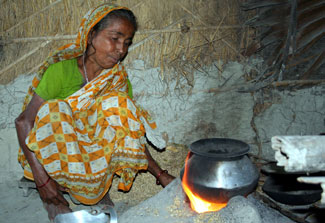Measuring health impact of indoor air pollution is key
January / February 2015 | Volume 14, Issue 1

Photo by Rezaul Haque, courtesy of Photoshare
Researchers met recently to discuss how to use biomarkers to
more accurately measure the exposure and health impact of indoor
air pollution.
In her hut in Zimbabwe, a mother stirs cornmeal in a pot above a wood fire, while the baby nestled on her back dozes. They are breathing in smoke laced with contaminants, their immune systems are chronically on overdrive and they face an increased risk of disease and early death.
Scientists are developing an array of interventions to prevent the 4 million premature deaths each year and other health burdens that the WHO attributes to indoor air pollution. Many projects encourage cleaner ways to cook and heat homes - currently more than a third of stoves use wood, dung, crop residues or other so-called biomass - or to ventilate the smoke better. Yet even as the global community rallies behind a range of interventions, there is no clear-cut way to evaluate exposure levels in individuals and the possible benefits of interventions to human health. Researchers hope to identify and establish a standard panel of indicators and biomarkers - physiological measures or molecules in bodily fluids or tissues - that can provide more precise evidence of effectiveness.
Developing the best targets for different exposure conditions is important for efficiency and precision and is critical to making valid comparisons between studies, said Fogarty senior scientist, Dr. Joshua Rosenthal. "We don't want scientists to reinvent the wheel every time they go out and work with different markers."
To spur research into biomarkers, especially those tied to the noncommunicable diseases commonly caused by indoor air pollution - such as cancer, respiratory conditions and cardiovascular disease - the public-private Global Alliance for Clean Cookstoves, in coordination with the NIH, recently held a meeting in Washington, D.C. The Alliance has about 1,000 public and private partners, including NIH, and plans to introduce 100 million clean cookstoves by 2020.
Speakers discussed a range of tests that have been used in studies on indoor air pollution and health. For instance, one team gauged cardiovascular disease by analyzing blood levels of a commonly tested protein tied to inflammation, C-reactive protein. Meanwhile, a team in India investigating hypertension used an automated device to record blood pressure and blood tests for readings on platelets, lipoproteins and antibodies.
Researchers studying lung function have looked at carbon monoxide levels in exhalations during cooking, to assess exposure levels. Many projects have measured breath capacity such as forced expiratory volume - a test for how much air can be rapidly pushed from the lungs - but one multi-country study highlighted a complexity inherent in many biomarkers: normal lung capacity can vary substantially depending on age, height and sex, and also between regions of the world, based on genetic, socioeconomic and environmental factors, making it harder to compare healthy levels.
Aside from carbon monoxide, other common contaminants found in smoke from cooking are particulate matter and organic compounds known as polycyclic aromatic hydrocarbons (PAH). The latter can now be detected in urine, providing another exposure marker for scientists.
Researchers must devise appropriate biomarker tests that are low-cost, portable for use in remote areas, can sustain temperature fluctuations in the absence of refrigeration, and generate reproducible results. In a recent project in Honduras, rather than drawing blood from participants, researchers used a cheaper, more convenient method - collecting blood samples on filter paper via finger pricks and drying them at room temperature. These spots are sufficient for analyzing many markers of cardiovascular health, as well as diabetes and other diseases. Another type of biomarker with potential use in this field is DNA readings from saliva, which could produce evidence of chronic illness.
Meeting attendees emphasized the potential for researchers to leverage existing studies to evaluate possible indicators and biomarkers for chronic respiratory and cardiovascular disease, so they can more accurately measure and demonstrate the benefits of clean cookstoves.
More Information
To view Adobe PDF files,
download current, free accessible plug-ins from Adobe's website.